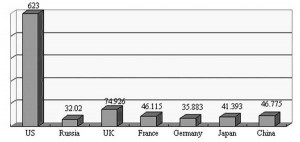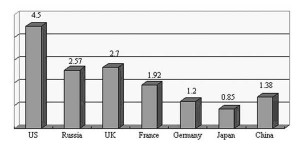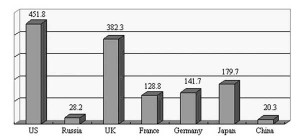Budget growth
One could ask, if the situation has improved so much and the threat perception decreased, why increase the defense budget by 20 percent?
The WP in a way answer this question: the defense budget had to be increased for three reasons:
Though the United States “welcomes the rise of a stable, peaceful, and prosperous China”, the Pentagon admits that: “Much uncertainty surrounds Chinas future course, in particular in the area of its expanding military power and how that power might be used.”
- Increasing the salaries and benefits of servicemen.
- Compensating for price hikes such as the rise in price of food, building materials, fuel, etc.
- Pushing forward the RMA [Revolution in Military Affairs]. China has augmented the input into military informationization and moderately increased the funds for equipment and supporting facilities, so as to raise the defense capabilities in conditions of informationization.
The transformation of the PLA into a modern force is one important component of the budget increase.
Beijing justifies thus its approach: “Both the total amount and per-service-person share of China’s defense expenditure remain lower than those of some major powers. In 2007 China’s defense expenditure equaled 7.51 percent of that of the United States, 62.43 percent of that of the United Kingdom. China’s defense expenses per-service-person amounted to 4.49 percent of that of the United States, 11.3 percent of that of Japan, 5.31 percent of that of the United Kingdom, 15.76 percent of that of France and 14.33 percent of that of Germany.”
It is the RMA field which absorbs most of the budgetary increment (hidden or disclosed). It is clear from the Chinese declaration of intention that a large chunk of the defense budget’s increase goes towards preparation of ‘informationized wars’.
Two months after the release of the WP, Premier Wen Jiabao delivered his annual speech at the National People’s Congress. According to Xinhua, he reaffirmed that: “China will transform its military training based on mechanized warfare to that based on informationized warfare. In the coming year, we need to make our army more revolutionary, modern and standardized.”
In his report, the Premier explained: “The building of computerized armed forces has entered a new era of all-round development.” It was also announced that Beijing planned to increase its defense budget by 14.9 percent to US $ 70 billion in 2009.
The Chinese Premier reiterated the other arguments for larger budget needs (rise increase in salary and compensation for inflation).
Outreach Diplomacy
As already mentioned, China’s positive image in the world is a significant motivation for Beijing. The WP states: “It takes military operations other than war (MOOTW) as an important form of applying national military forces, and scientifically makes and executes plans for the development of MOOTW capabilities. China participates in international security cooperation, conducts various forms of military exchanges and promotes the establishment of military confidence-building mechanisms in accordance with this guideline.”
 It is in this context that India appears in the WP: “China has begun to hold defense and security consultations with India.”The WP elaborates: “Since 2007 China has held over 20 joint military exercises or joint training exercises with a score of countries. …In December 2007 and December 2008, armies of China and India staged joint counter-terrorism training exercises respectively in Kunming, China and Belgaum, India.”
It is in this context that India appears in the WP: “China has begun to hold defense and security consultations with India.”The WP elaborates: “Since 2007 China has held over 20 joint military exercises or joint training exercises with a score of countries. …In December 2007 and December 2008, armies of China and India staged joint counter-terrorism training exercises respectively in Kunming, China and Belgaum, India.”
We shall refrain from commenting about these exercises, though it seems strange that India needs to train China in ‘counter-terrorism’.
The participation of the Chinese navy in the anti-piracy operations off the coast of Somalia is certainly an important development for China. It is “probably more of a sign of things to come than a one-off publicity stunt,” says Adam Wolfe in his ISN Security Watch’s article.
Further, China has about 1,950 military peacekeepers serving in nine UN missions last year. It is an unprecedented effort.
The US view
Washington does not see Beijing’s growing defense budget through the same eyes. Though the United States “welcomes the rise of a stable, peaceful, and prosperous China”, the Pentagon admits that: “Much uncertainty surrounds China’s future course, in particular in the area of its expanding military power and how that power might be used.”
 According to the latest Annual Report to Congress – Military Power of the People’s Republic of China, 2008,9 “The PLA is pursuing comprehensive transformation from a mass army designed for protracted wars of attrition on its territory to one capable of fighting and winning short-duration, high intensity conflicts along its periphery against high-tech adversaries – an approach that China refers to as preparing for local wars under conditions of informatization.”The US Report believes that the PLA is developing capabilities for use in other contingencies, such as conflict over resources or disputed territories.10
According to the latest Annual Report to Congress – Military Power of the People’s Republic of China, 2008,9 “The PLA is pursuing comprehensive transformation from a mass army designed for protracted wars of attrition on its territory to one capable of fighting and winning short-duration, high intensity conflicts along its periphery against high-tech adversaries – an approach that China refers to as preparing for local wars under conditions of informatization.”The US Report believes that the PLA is developing capabilities for use in other contingencies, such as conflict over resources or disputed territories.10
This is of course not mentioned in the WP.
 Though the publication of regular updated WPs is a small progress towards a greater transparency, China’s military development remains very opaque. As the Report to the Congress asserts: “The international community has limited knowledge of the motivations, decision-making, and key capabilities supporting China’s military modernization. China’s leaders have yet to explain in detail the purposes and objectives of the PLA’s modernizing military capabilities. For example, China continues to promulgate incomplete defense expenditure figures, and engage in actions that appear inconsistent with its declaratory policies. The lack of transparency in China’s military and security affairs poses risks to stability by increasing the potential for misunderstanding and miscalculation. This situation will naturally and understandably lead to hedging against the unknown.”
Though the publication of regular updated WPs is a small progress towards a greater transparency, China’s military development remains very opaque. As the Report to the Congress asserts: “The international community has limited knowledge of the motivations, decision-making, and key capabilities supporting China’s military modernization. China’s leaders have yet to explain in detail the purposes and objectives of the PLA’s modernizing military capabilities. For example, China continues to promulgate incomplete defense expenditure figures, and engage in actions that appear inconsistent with its declaratory policies. The lack of transparency in China’s military and security affairs poses risks to stability by increasing the potential for misunderstanding and miscalculation. This situation will naturally and understandably lead to hedging against the unknown.”
The report added: “The pace and scope of China’s military transformation have increased in recent years, fueled by acquisition of advanced foreign weapons, continued high rates of investment in its domestic defense and science and technology industries, and far reaching organizational and doctrinal reforms of the armed forces.”
This is particularly true for China’s nuclear force modernization and particularly worrying not only in Washington, but in several other capitals (probably excluding Delhi, as it is not in the Indian psyche to worry).






China is a nation on the verge of being a super power. They are not on the waprath, nor are they being aggressive in any way. I do not expect a War with China anytime in the near future. And good for the AUssies.. they are our close allies, a big aussie military means better military support for American troops by the int’l community.